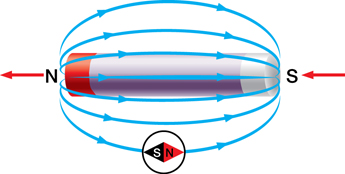Module 4
1. Module 4
1.8. Page 6
Module 4—Magnetic and Electric Fields in Nature and Technology
 Lesson Summary
Lesson Summary
In this lesson you focused on the following essential questions:
-
What is a magnetic field?
-
How is Earth’s magnetic field produced?
-
What is the significance of a current-carrying conductor inducing a magnetic field?

The magnetic field of a bar magnet can be represented by magnetic field lines. The density of lines at a given point indicates the intensity of the field at that point.
Compass needles align themselves with the direction of the magnetic field. The magnetic field surrounding a bar magnet is from north to south.
When a compass is placed in a magnetic field, the north pole of the compass needle points in the same direction as the field.
Arrows are used to indicate the direction of a magnetic field line.
In three dimensions, magnetic field lines coming towards the observer are represented with dots and those going away from the observer are represented with x’s. The arrows are symbolic representations since the magnetic field is invisible to the eye.

Magnetic fields are produced by moving charge, according to Ørsted’s observations that a circular magnetic field surrounds a current-carrying conductor. The directions of the magnetic field surrounding a current-carrying wire or through a coil of wire (solenoid) can be identified using hand rules.
All magnetic fields can be explained by the motion of moving charges. Earth’s magnetic field is created by the motion of molten iron and nickel in Earth’s core. The magnetic properties of a permanent magnet are explained using domain theory, which relates the synchronized motion of electrons in small chunks of ferromagnetic material like soft iron.
The connection between moving charge and the production (induction) of magnetic fields is the first step in understanding electromagnetism that is observed in nature and used in modern technologies, such as electrical generators and motors.
Lesson Glossary
domain: the region of a material in which the magnetic fields of most of the atoms are aligned
ferromagnetic material: a metal with adjacent atoms having electron movement that, taken together, form a small region with an intense magnetic field
magnetic field: a three-dimensional region of magnetic influence surrounding a magnet in which other magnets or magnetic substances are affected by magnetic forces
magnetic flux: the number of magnetic field lines passing through a given area perpendicular to the field
solenoid: an electromagnet that operates a mechanical device by using the magnetic field produced by a current-carrying conductor wrapped into a coil
tesla: a unit of magnetic field strength (T) defined as one ![]() or one
or one ![]()